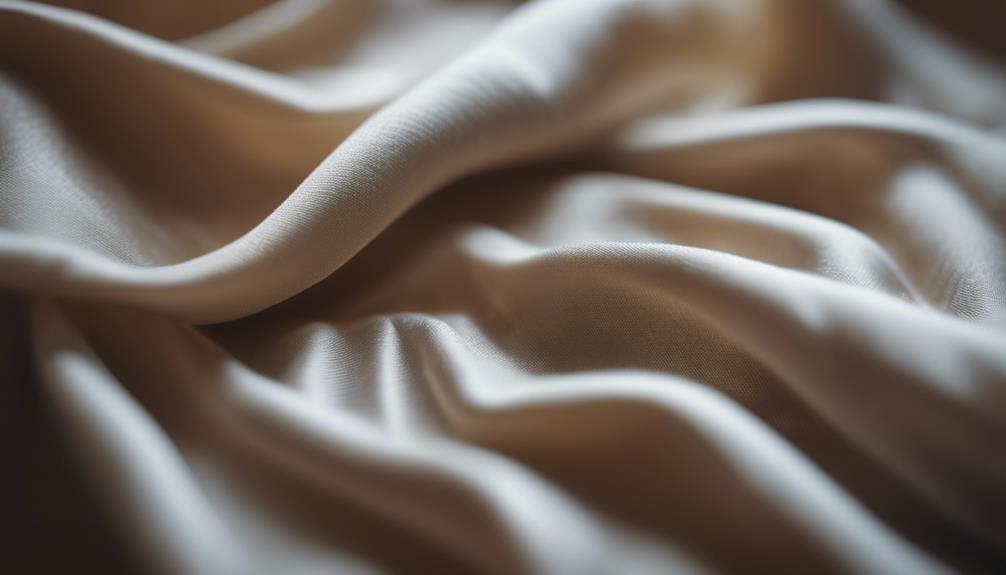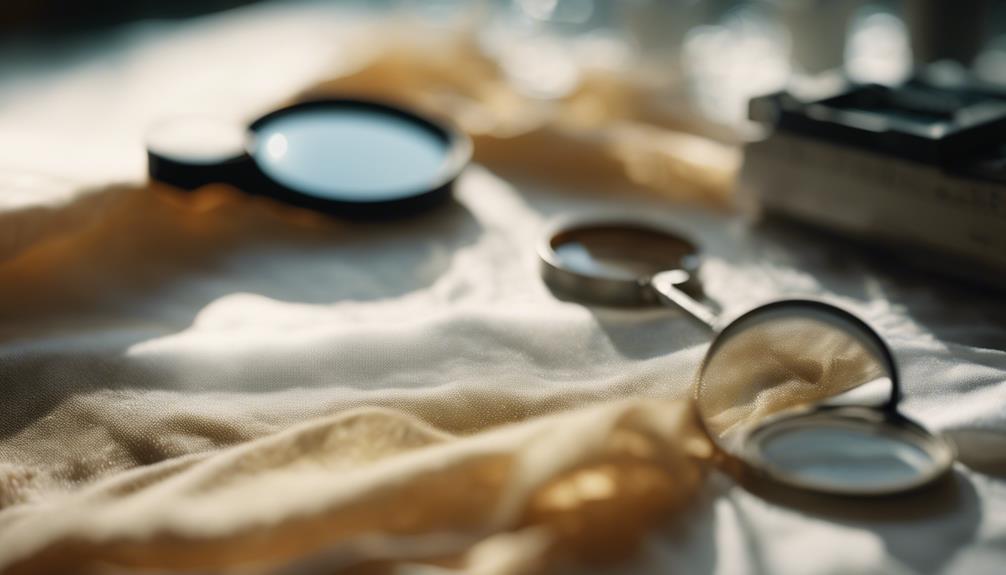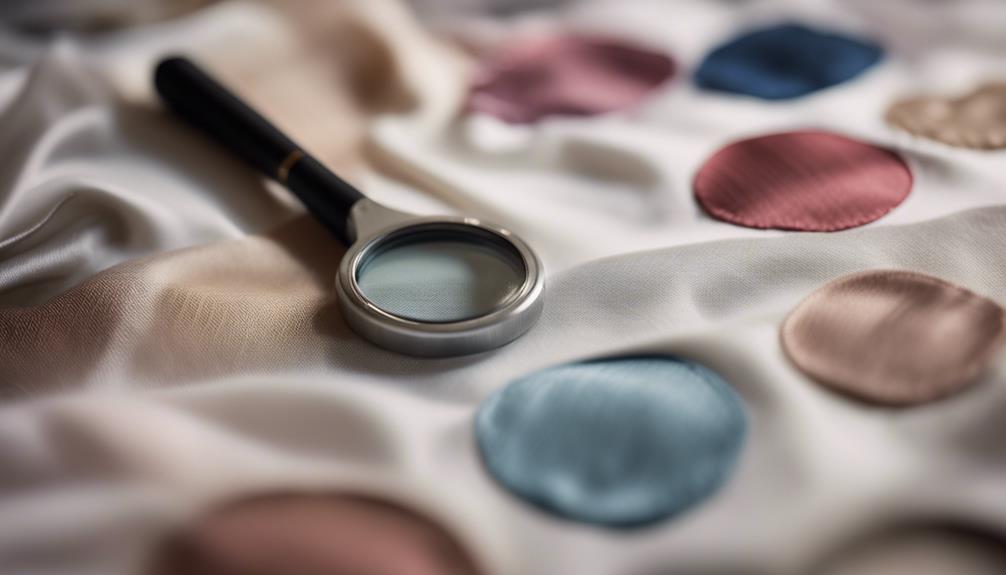To identify rayon, start by checking its texture—it's incredibly soft and smooth, like silk. Look for a glossy finish that sets it apart from matte fabrics like cotton. Perform a burn test; rayon burns quickly and smells like burning leaves while leaving brittle ash. Observe how it absorbs moisture; rayon dries faster than cotton. Finally, notice how it drapes; rayon flows fluidly rather than feeling stiff. These characteristics will help you pinpoint rayon in your wardrobe. If you're curious about its versatile uses and care tips, you'll find more insights right ahead.
Understanding Rayon Composition

When you look at rayon, it's essential to understand its composition to appreciate its unique qualities. Rayon is a semi-synthetic fiber derived from natural cellulose sources, primarily wood pulp, cotton linters, or bamboo. The manufacturing process involves a chemical transformation of cellulose into a soluble compound, which is then regenerated into fibers. This classification as a regenerated fiber highlights its blend of natural and synthetic characteristics.
Rayon retains many properties of natural fibers, making it highly absorbent and soft. It's often compared to silk due to its luxurious texture. Depending on the type of rayon—such as viscose, modal, or lyocell—the manufacturing process can vary, impacting its overall properties. For example, lyocell is produced using sustainable methods that minimize environmental impact, thanks to a closed-loop process that recycles water and solvents.
When testing for rayon, it's also useful to know that the fabric burns differently than many other materials. Rayon tends to ignite quickly, producing a smell similar to burnt paper. By understanding these aspects of rayon's composition, you'll be better equipped to identify and appreciate this versatile fabric.
Key Characteristics of Rayon
Rayon boasts several key characteristics that make it a popular choice for clothing and textiles. First and foremost, rayon fabrics are incredibly soft and comfortable, often compared to silk in texture. This softness is due to its semi-synthetic nature, as it's made from natural cellulose sources like wood pulp and bamboo.
One of rayon's standout features is its ability to absorb moisture, which makes it ideal for warm weather wear. You'll appreciate how it wicks away sweat, keeping you cool and dry in flowing garments like dresses and blouses. Additionally, rayon has a glossy finish that enhances color vibrancy, allowing it to mimic the look of various fabrics, including cotton and wool.
However, it's important to know the fibre content when shopping, as rayon is less durable than cotton and prone to wrinkling. It can shrink and fade over time, requiring careful handling. You might want to assess the Burn Test to confirm its identity, as rayon will produce a distinct smell similar to burning paper. By understanding these key characteristics, you'll be better equipped to choose the right rayon items for your wardrobe.
Identifying Rayon Through Tests

To accurately identify rayon, you can perform a series of simple tests that highlight its unique properties. Start with the burn test: ignite a small swatch of the Rayon Fabric. You'll notice it burns quickly, producing a smell reminiscent of burning leaves and leaving behind fine, brittle ash. Next, conduct a water absorption test by placing a drop of water on the fabric. Rayon absorbs moisture rapidly and dries faster than cotton, showcasing its high absorbency.
Examine the texture of the fabric as well. Rayon typically has a smooth and soft feel, resembling silk, while cotton feels more textured and crisp. You can also check for sheen; rayon often has a glossy finish, whereas cotton generally appears matte. Finally, assess the drape of the fabric. Rayon tends to flow fluidly and gracefully, while cotton retains a stiffer structure.
| Test | Result |
|---|---|
| Burn Test | Smell of burning leaves |
| Water Absorption | Quick absorption and drying |
| Look and Feel | Smooth, soft texture |
| Drape | Flows fluidly |
Practical Uses of Rayon
With its soft texture and excellent draping qualities, rayon has found a prominent place in various practical applications. You'll often see rayon used in clothing, especially in dresses, blouses, and linings, where its flowing nature enhances the overall look. If you're looking for comfortable activewear or loungewear, rayon's high absorbency makes it a great choice, providing breathability and comfort during warm weather.
In the domain of home textiles, rayon shines in items like curtains and upholstery. Its ability to retain vibrant colors adds a luxurious feel to your living spaces, making them more inviting. Beyond fashion and home décor, rayon exhibits versatility in industrial applications as well. You can find it in tire cords and non-woven fabrics, showcasing its adaptability across different sectors.
Rayon is even utilized in medical supplies, such as bandages, due to its moisture-wicking properties. This fabric's broad range of uses—from clothing to home textiles and beyond—illustrates just how practical and effective rayon can be in your everyday life. Whether you're dressing up or enhancing your home, rayon is a reliable choice.
Care Tips for Rayon Fabrics

Caring for rayon fabrics requires a bit of attention to detail to keep them looking their best. When washing rayon, it's best to hand wash or dry clean to avoid any damage. Use cool or lukewarm water and mild detergents to prevent color fading and fabric degradation. If you choose to wash it, be gentle and avoid wringing the fabric, as this can cause it to lose shape.
After washing, air drying is the preferred method for rayon. Skip the tumble dryer, as the heat can lead to shrinking and distortion. Instead, lay your garments flat or hang them in a cool, dry place away from direct sunlight.
When it comes to ironing, set your iron to low heat. Using steam will help remove wrinkles without scorching the fabric. Finally, store your rayon garments carefully; avoid hanging them for long periods to prevent stretching and guarantee they remain in top condition. By following these care tips, you'll keep your rayon fabrics looking fresh and vibrant for years to come.
Frequently Asked Questions
What Does Rayon Look Like?
When you look at rayon, you'll notice its soft, smooth texture and glossy finish. The vibrant colors stand out, and its beautiful drape gives garments an elegant silhouette, making it a popular choice for fashion.
How Can You Tell the Difference Between Rayon and Nylon?
You can tell the difference between rayon and nylon by burning a small sample. Rayon emits a smell like burning leaves, while nylon smells chemical. Additionally, rayon leaves brittle ash, whereas nylon creates a shiny bead.
What Is the Burn Test for Rayon?
The burn test for rayon involves igniting a small fabric swatch. You'll notice quick ignition, a burning leaf smell, black smoke, and brittle ash, helping you distinguish it from other fibers safely and effectively.
What Does Rayon Mimic?
Rayon mimics the luxurious feel of silk, the breathability of cotton, and even the glossy sheen of satin. It can also resemble wool's warmth, providing you with versatile options for various styles and occasions.





It’s perfect time to make some plans for the future and it’s time to be happy.
I have read this post and if I could I desire to
suggest you few interesting things or suggestions.
Perhaps you can write next articles referring to this article.
I desire to read even more things about it!
casino en ligne
Heya i am for the first time here. I found this board and I to find
It truly useful & it helped me out a lot. I am hoping to provide one thing back and help others such as you helped me.
casino en ligne
Unquestionably believe that which you said. Your favorite reason seemed to be on the
internet the easiest thing to be aware of. I say to you, I certainly get irked while people consider worries that
they plainly don’t know about. You managed to
hit the nail upon the top and also defined out the
whole thing without having side effect , people can take a signal.
Will probably be back to get more. Thanks
meilleur casino en ligne
Howdy would you mind sharing which blog platform you’re
using? I’m looking to start my own blog in the near future but I’m having
a tough time selecting between BlogEngine/Wordpress/B2evolution and Drupal.
The reason I ask is because your design seems different then most blogs and I’m looking for something unique.
P.S My apologies for getting off-topic but I had to ask!
casino en ligne France
Pretty section of content. I just stumbled upon your site and in accession capital to assert that I acquire actually enjoyed account your blog posts.
Anyway I will be subscribing to your augment and even I achievement you access consistently fast.
casino en ligne
Woah! I’m really loving the template/theme of this site. It’s simple, yet effective.
A lot of times it’s very difficult to get that “perfect balance” between user friendliness and visual appeal.
I must say you’ve done a amazing job with this. Also, the
blog loads extremely fast for me on Firefox. Excellent Blog!
casino en ligne fiable
Wonderful website you have here but I was wondering if you knew of any discussion boards that cover the same topics discussed in this article?
I’d really like to be a part of community where I can get comments from other
experienced individuals that share the same interest.
If you have any suggestions, please let me know.
Many thanks!
casino en ligne
This info is priceless. Where can I find out more?
casino en ligne
It’s difficult to find educated people for this subject, but you seem like you know what you’re talking about!
Thanks
meilleur casino en ligne
Sweet blog! I found it while browsing on Yahoo News.
Do you have any tips on how to get listed in Yahoo
News? I’ve been trying for a while but I never seem to get there!
Many thanks
casino en ligne francais
MultiChain
Exhibition stand designers
Can you be more specific about the content of your article? After reading it, I still have some doubts. Hope you can help me. https://www.binance.info/fr/register-person?ref=GJY4VW8W
I like the helpful information you provide in your articles.
I will bookmark your blog and check again here frequently.
I am quite sure I’ll learn a lot of new stuff right here!
Best of luck for the next!
Thanks for sharing. I read many of your blog posts, cool, your blog is very good.